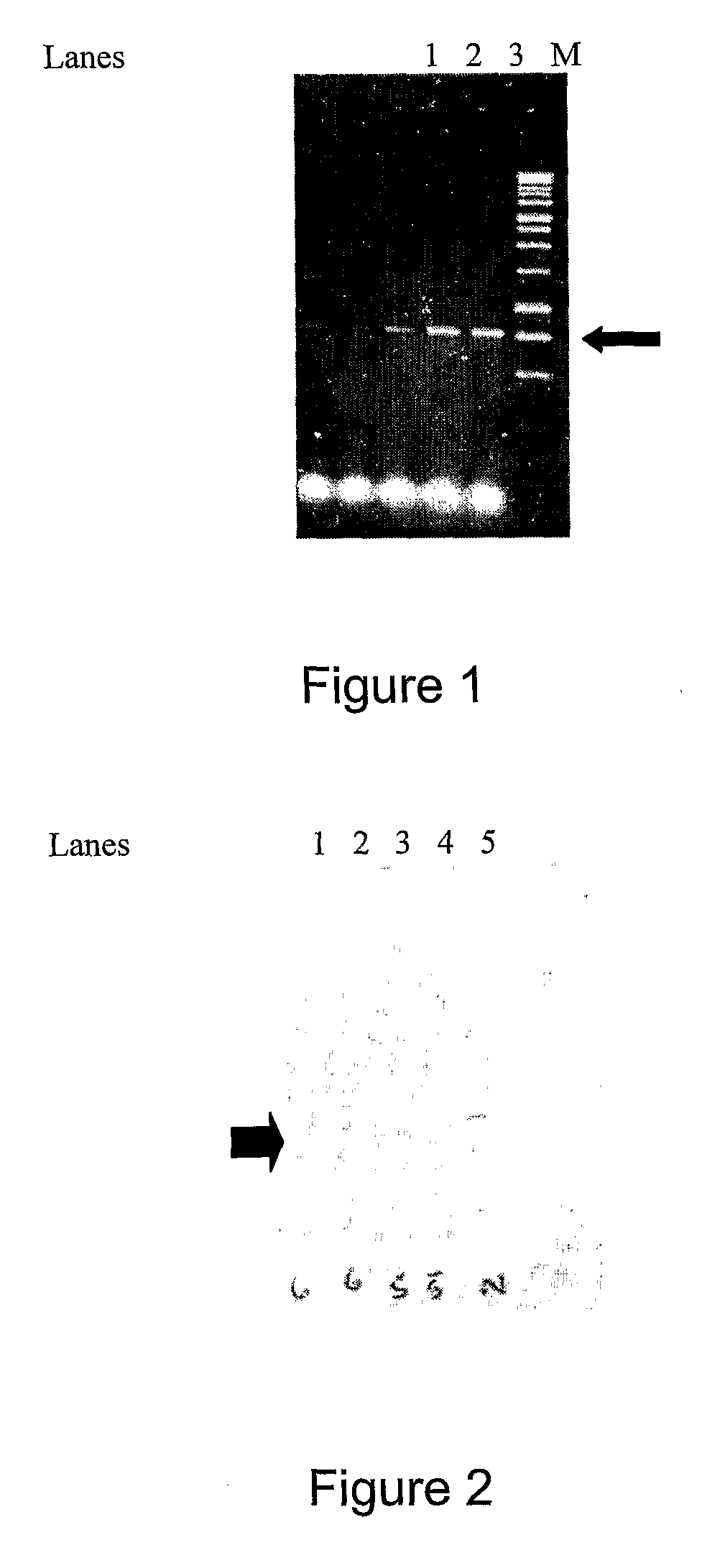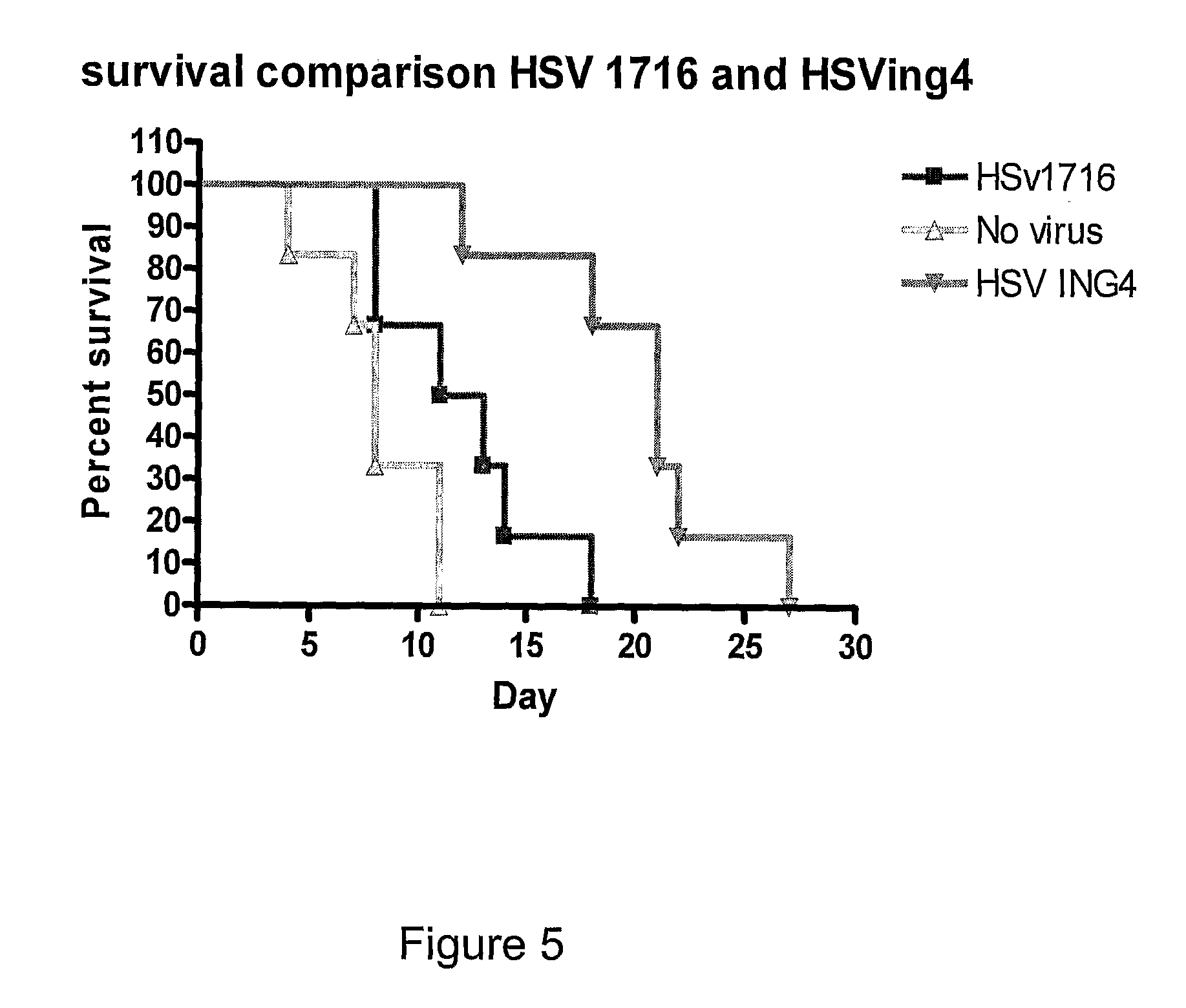Herpes simplex viruses and methods of viral replication
a technology of herpes simplex and viral replication, applied in the field of herpes simplex viruses, can solve the problems of unguaranteed ability of a broad spectrum first-generation oncolytic virus to replicate in or provide an effective treatment for all tumour types, and achieve the effects of reducing the average tumour volume, reducing the survival time of mice receiving the herpes simplex virus variant, and improving the ability to retard tumour growth
- Summary
- Abstract
- Description
- Claims
- Application Information
AI Technical Summary
Benefits of technology
Problems solved by technology
Method used
Image
Examples
example 1
In Vivo Experiments
Intratumoral Injection of Nude Mice Bearing Subcutaneous Tumour Implants
[0138]In an initial experiment, 6 mice with subcutaneous implants of the CP70 ovarian tumour cell line were injected intratumorally with 1×107 pfu HSV1716ING4 on days 1 and 3 and tumour growth and survival was monitored daily. Control mice were either injected with HSV1790, an HSV1716 variant expressing the enzyme nitroreductase, or were injected with a similar volume of PBS. Survival data is shown in FIG. 3.
[0139]Of the 6 mice treated with HSV1716ING4, 1 tumour showed complete regression, 4 tumours grew at a slower rate than the untreated tumours and 1 tumour became ulcerated and the mouse was removed from the analysis. Using survival times (as measured by when the tumour reached the upper acceptable limit) to assess each of the treatments, animals treated with the ING 4 virus had an average survival of 23.5 days compared to animals treated with no virus or those treated with HSV1790 which ha...
example 2
In Vitro Experiments
Propagation of HSV1716ING4 on Different Cell Lines
[0145]The above in vivo data suggests that HSV1716ING4 demonstrates enhanced oncolysis by replicating with higher efficiency than unmodified HSV1716 and this was confirmed in vitro using a variety of different cells lines infected at low multiplicities of infection. Cell lines used were BHK, Vero, A431 human SCC, CP70 human ovarian tumour, MDA-MB-468 human breast adenocarcinoma, Ovcar3 human ovarian carcinoma and HuH7 human hepatocellular carcinoma and propagation of HSV1716ING4 in these lines was compared with wild-type HSV-1 17+, HSV1716, HSV1716ING4 and HSV1716EGFR (an EGFR-targeted HSV1716 variant that expresses a targeting moiety approximately the same molecular size as ING4).
[0146]Cells were plated out in 60 mm dishes and after 24 hours they were infected with approximately 100 pfu (BHK only) or 1000 pfu (all other cell types) HSV-1 17+, HSV1716, HSV1716ING4 or HSV1716EGFR. Dilutions of each virus preparatio...
example 3
Preliminary In Vitro Experiments
[0160]The in vivo data suggested that HSV1716ING4 replicated with higher efficiency than unmodified HSV1716. This was initially confirmed in vitro using a variety of different cells lines infected at low multiplicities of infection, as described below. These experiments were followed up with the experiments described in Example 2.
[0161]Cell lines used were BHK, Vero, 3T6, A431 human SCC, CP70 ovarian tumour, MDA human breast carcinoma, Ovcar3 human ovarian carcinoma and UVW human glioblastoma and they were infected principally with HSV1716, HSV1716ING4 and HSV1716EGFR.
[0162]Experiment 1. Cells were plated out in 60 mm dishes and after 24 hours they were infected with 1, 10 or 100 pfu HSV1716, HSV1716ING4 or HSV1716EGFR. After 72 hours of infection, cells and medium were harvested, subjected to one freeze / thaw cycle (−70° C.) and, as each of these viruses expresses gfp, a TCID method was used to estimate the amounts of virus in each sample. Results are...
PUM
| Property | Measurement | Unit |
|---|---|---|
| nucleic acid sequence | aaaaa | aaaaa |
| microvascular density | aaaaa | aaaaa |
| survival time | aaaaa | aaaaa |
Abstract
Description
Claims
Application Information
 Login to View More
Login to View More - R&D
- Intellectual Property
- Life Sciences
- Materials
- Tech Scout
- Unparalleled Data Quality
- Higher Quality Content
- 60% Fewer Hallucinations
Browse by: Latest US Patents, China's latest patents, Technical Efficacy Thesaurus, Application Domain, Technology Topic, Popular Technical Reports.
© 2025 PatSnap. All rights reserved.Legal|Privacy policy|Modern Slavery Act Transparency Statement|Sitemap|About US| Contact US: help@patsnap.com



